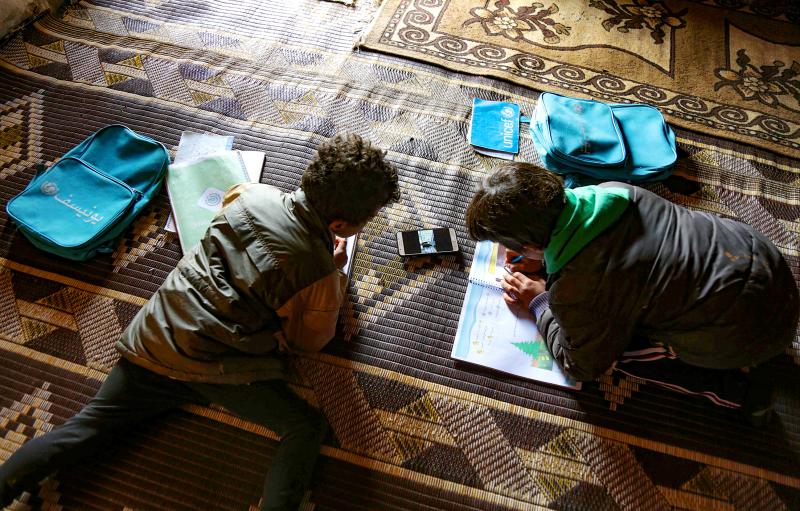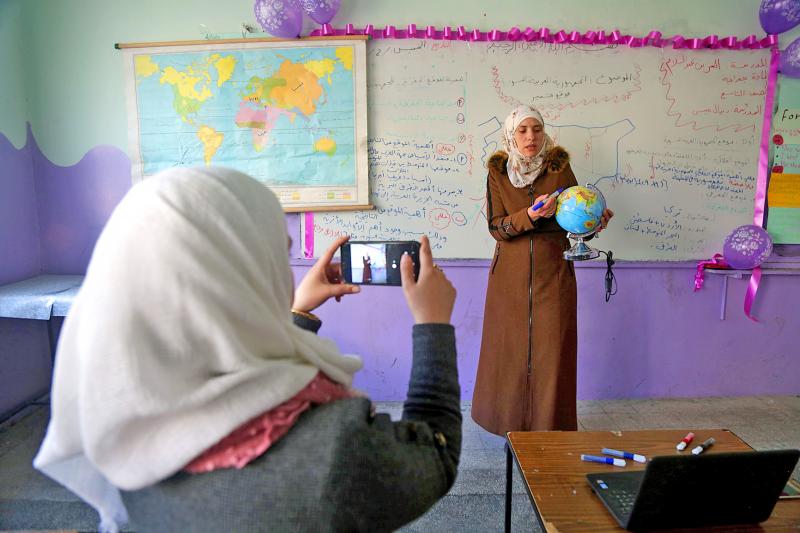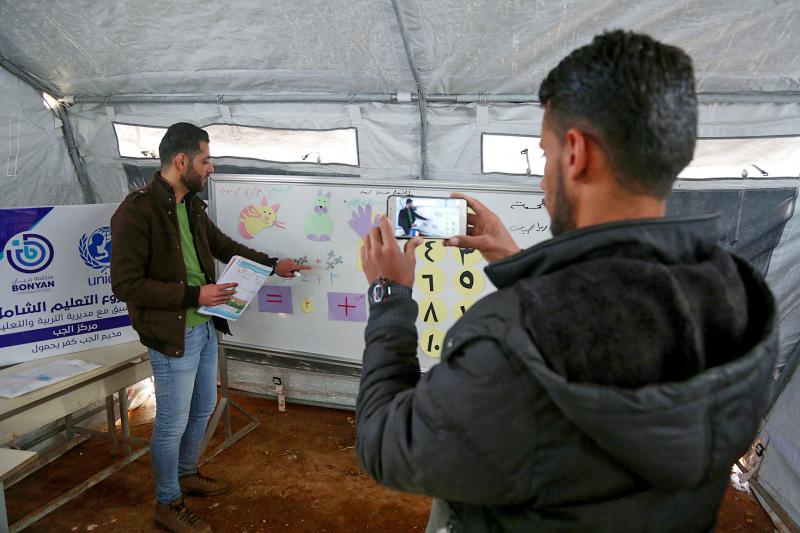Staring into a smartphone camera in an empty classroom in rebel-held northwest Syria, geography teacher Danielle Dbeis addresses students confined at home away from the 2019 novel coronavirus.
“Even if we are now doing distance learning ... you can still talk to me online,” says the 42-year-old, standing in front of a white board.
Like in much of the world, educators in Syria are taking classes online after the country’s various regions sent pupils home hoping to stem the COVID-19 pandemic.

Photo: AFP
But distance learning is no small feat in a country battered by nine years of war, where fighting has displaced millions and the electricity supply is sporadic at best.
Syria’s last major rebel bastion of Idlib has not yet recorded any case of the virus. But aid workers fear any outbreak would be catastrophic in the region, which is under a jihadist-dominated authority and home to at least 3 million people.
In the main city of Idlib, Dbeis points to a map of Syria she has drawn on the white board, her voice bouncing off the walls of the empty classroom.

Photo: AFP
Her school used to teach 1,000 girls before it closed last month, she says, but now only 650 have continued learning online as the others have no access to a smartphone or laptop.
Even those with the right equipment face difficulties, says the teacher, who uses WhatsApp to send her students videos. “Most students don’t have constant access to the internet,” she says.
And during long power cuts, she adds, they “are not able to charge their phones.”

Photo: AFP
LATEST OF MANY OBSTACLES
At home elsewhere in Idlib city, Nour Sermini spends her days with her eyes riveted on her mobile phone screen, books and notes scattered around her on her bed.
Switching from one WhatsApp group to another, the 17-year-old checks in with her various teachers.
“We’ll do anything not to miss out on our education,” she says.
The deadly virus is just the latest of many obstacles to learning in Idlib, she says, after years of air strikes on the surrounding region by Damascus and its ally Russia.
“The bombs didn’t manage to stop us from learning,” and neither will the virus, she says.
Since March, a fragile truce has held in northwest Syria. But months of bombardment before that disrupted the education of some 280,000 children, the UN Children’s Fund says.
Across the Idlib region, more than half of the 1,062 schools are now damaged, destroyed or in areas too dangerous for children to reach, according to Save the Children.
Displaced from their homes in the rounds of violence, hundreds of thousands of children live in overcrowded camps or temporary shelters, with little to no water or electricity.
In one of these camps, in the village of Kafr Yahmoul, Ahmed Rateb has just finished recording a math class in a tent.
“We’re trying as much as possible not to deprive the kids of an education,” says the 29-year-old teacher, who sends along his tutorials on Telegram and WhatsApp.
But some are now unable to follow for lack of a smart screen as well as long blackouts inside the camp, he admits.
INTERNET AND POWER ISSUES
As the civil war enters its tenth year, the Damascus regime controls around 70 percent of Syrian territory after successive victories against jihadists and rebels.
In these territories too, where Damascus has announced 19 cases of COVID-19 including two deaths, schools have closed their gates.
To make up for lost time, the education ministry has started beaming Arabic, English and science classes into homes via a special television channel.
But there too, power cuts can last up to 14 hours a day, and the government caps the size of Internet bundles allowed for each family.
In the northeast of the country, the semi-autonomous Kurdish authorities are looking to launch distance learning within days, education official Nureddin Mohammad says.
No case of the novel coronavirus has yet been announced in the region, where medical supplies are limited and there are no tests.
Teachers are filming classes to be broadcast on local television channels and on Youtube, and teachers will keep in touch with pupils via WhatsApp, he says.
Bandar Ismail, a 35-year-old father of three, says he cannot wait for the first episodes.
But he wonders whether the authorities will be “able to ensure sufficient power and Internet for the project to succeed.” Kurdish language teacher Hayat Abbas, meanwhile, says she already misses teaching students in person.
In distance learning, “it’s just a half-an-hour lecture or less, and we try to explain as much as possible,” the 43-year-old says.
“But you can’t answer pupils’ questions.”

Exceptions to the rule are sometimes revealing. For a brief few years, there was an emerging ideological split between the Democratic Progressive Party (DPP) and Chinese Nationalist Party (KMT) that appeared to be pushing the DPP in a direction that would be considered more liberal, and the KMT more conservative. In the previous column, “The KMT-DPP’s bureaucrat-led developmental state” (Dec. 11, page 12), we examined how Taiwan’s democratic system developed, and how both the two main parties largely accepted a similar consensus on how Taiwan should be run domestically and did not split along the left-right lines more familiar in

As I finally slid into the warm embrace of the hot, clifftop pool, it was a serene moment of reflection. The sound of the river reflected off the cave walls, the white of our camping lights reflected off the dark, shimmering surface of the water, and I reflected on how fortunate I was to be here. After all, the beautiful walk through narrow canyons that had brought us here had been inaccessible for five years — and will be again soon. The day had started at the Huisun Forest Area (惠蓀林場), at the end of Nantou County Route 80, north and east

Specialty sandwiches loaded with the contents of an entire charcuterie board, overflowing with sauces, creams and all manner of creative add-ons, is perhaps one of the biggest global food trends of this year. From London to New York, lines form down the block for mortadella, burrata, pistachio and more stuffed between slices of fresh sourdough, rye or focaccia. To try the trend in Taipei, Munchies Mafia is for sure the spot — could this be the best sandwich in town? Carlos from Spain and Sergio from Mexico opened this spot just seven months ago. The two met working in the

This month the government ordered a one-year block of Xiaohongshu (小紅書) or Rednote, a Chinese social media platform with more than 3 million users in Taiwan. The government pointed to widespread fraud activity on the platform, along with cybersecurity failures. Officials said that they had reached out to the company and asked it to change. However, they received no response. The pro-China parties, the Chinese Nationalist Party (KMT) and Taiwan People’s Party (TPP), immediately swung into action, denouncing the ban as an attack on free speech. This “free speech” claim was then echoed by the People’s Republic of China (PRC),